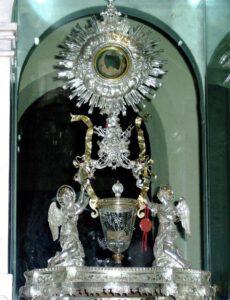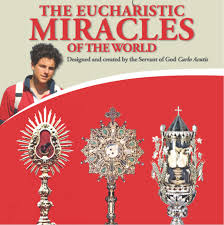The importance of today’s Solemnity cannot be overstated: it represents the homage that is due to the Holy Eucharist, the ‘source and summit of Christian life’ (CCC 1324-1327). The Sacrament was instituted on Holy Thursday, but given the sombreness of that liturgical time, it does not get the attention that it deserves. No doubt, it is the highlight of every single Holy Sacrifice of the Mass; yet, Dies Sanctissimi Corporis et Sanguinis Domini Iesu Christi is observed as its liturgical anniversary.
What to us today is ‘Holy Thursday’ was, in Jesus’ time, the first day of the week-long Feast of Unleavened Bread. That was the Passover, when the Jews ate unraised bread, in remembrance of what their ancestors had eaten as they fled Egypt; and they sacrificed a lamb, the animal whose blood they had once sprinkled on their doorposts (Exod. 12: 13-28) – to let the plague ‘pass over’ their households. This Passover or salvation is what the Jews gratefully celebrate ever since.

Jesus observed the Passover and made it infinitely relevant to us. He longed to celebrate his last one with the Apostles. The Gospel (Mk 14: 12-16, 22-26) tells us that He took bread, blessed and broke it, and gave it to them; then, He took a cup of wine (for there were four)[1], over which He gave thanks and of which the disciples then drank. The Meal, however, was not as light as it appears: there was lamb as well, which they ate with unleavened bread and washed down with wine. Yet Jesus chooses bread and wine over the lamb and its blood to represent His Body and Blood.
Many Jews found the idea of the Body and Blood, even if in the species of bread and wine, objectionable. The two species were however prefigured in the Old Testament: through Abram’s interaction with Melchizedek (Gen 14: 21) and the miraculous supply of manna in the wilderness (Deut. 8: 2-3, 14-16, in Cycle A), among other foreshadowing. In today’s First Reading (Exod. 24: 3-8), through Moses, God establishes a covenant with His people now free; the same was sanctioned by the blood of a victim offered in sacrifice, as all solemn promises were.
Jesus is the New Moses who makes a New Covenant by offering His own Body and Blood. The Second Reading (Heb. 9: 11-15) reiterates the point that the High Priest took not the blood of goats and calves but His own, thus securing an eternal redemption. He is the Lamb of God ‘who through the eternal Spirit offered Himself without blemish to God.’ The Mediator of the New Covenant made everything new; He has cancelled the transgressions of those who believe in Him and promised them eternal inheritance.
The significance of the Holy Eucharist was ever present before the eyes of the Christians since the earliest times. Doctrinal teaching only cemented the idea in their consciousness. ‘Transubstantiation’ was defined; Eucharistic miracles were witnessed (107 approved ones till date)[2], and Corpus Christi declared a universal feast. Priests and lay people down the ages have loved the Eucharistic Lord. In 1856, the French priest, now saint, Eymard, finding special solace in the love of God manifested in the Eucharist, founded the Congregation of the Blessed Sacrament.
Closer to our times, a word about the Blessed Carlo Acutis, soon to be canonised: He possessed a deep love and devotion to Christ in the Eucharist. As the internet was gaining popularity in the early 2000s, he helped form websites for parishes, the Vatican, and made a website with information on Eucharistic miracles. He begged his parents to take vacations to 17 different countries and journaled and took copious notes on everything he witnessed. Over a span of two-and-a-half years, he documented 187 Eucharistic miracles. In the midst of his travels, he and his family prayed before hosts that have turned into blood.[3] Visit the international exhibition designed and created by him.[4]

Like the Mystery of the Most Holy Trinity that is beyond human comprehension, the Holy Eucharist too is an ineffable Sacrament. However, in his apostolic exhortation Sacramentum Caritatis (Sacrament of Charity), Pope Benedict XVI, with reference to the presentation of the gifts, speaks of the relationship between the Eucharist and daily life: ‘In the bread and wine that we bring to the altar, all creation is taken up by Christ the Redeemer, to be transformed and presented to the Father. In this way we also bring to the altar all the pain and suffering of the world, in the certainty that everything has value in God’s eyes’ (No. 47).
Truly, just as God liberated the Israelites of old from the physical bondage of Egypt, Jesus liberates us from the bondage of sin and death.
-o-o-o-o-
[1] The Passover meal was divided fourfold: first, a dish of herbs was served and a festival blessing spoken over the first cup of wine; second, a recital of the Passover narrative and the Little Hallel (Psalm 113) and drinking of the second cup; the third was the main course (lamb and unleavened bread), after which was drunk the third cup of wine, called the “cup of blessing”; finally, there was the singing of the Great Hallel (Psalms 114-118) and the drinking of the fourth cup of wine. It is said that Jesus drank the third one only. Then he said, ‘I shall not drink again of the fruit of the vine until that day when I drink it anew in the kingdom of God.’ Accordingly, he refused the sour wine while on the Cross.
[2] Four Eucharistic miracles of the twenty-first century have been approved: Chirattakonam, India (2001); Tixtla, Mexico (2006), Sokolka, Poland (2008) and Legnica, Poland (2013).
This excellent article of yours on the Eucharist has helped me to reflect and thank God for this gift of divine love. Thanks specially for the enlightening notes at the end.